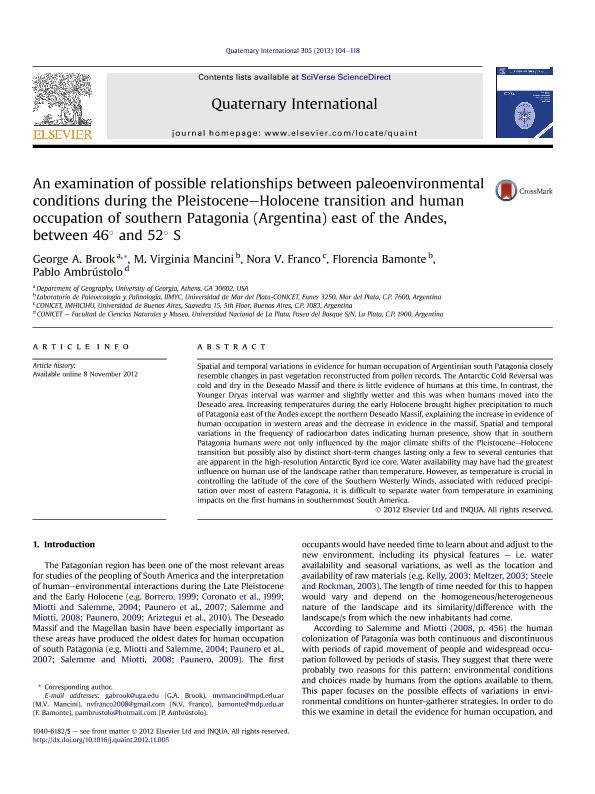Mostrar el registro sencillo del ítem
dc.contributor.author
Brook, George

dc.contributor.author
Mancini, Maria Virginia

dc.contributor.author
Franco, Nora Viviana

dc.contributor.author
Bamonte, Florencia Paula

dc.contributor.author
Ambrustolo, Pablo

dc.date.available
2020-04-02T15:01:11Z
dc.date.issued
2013-08
dc.identifier.citation
Brook, George; Mancini, Maria Virginia; Franco, Nora Viviana; Bamonte, Florencia Paula; Ambrustolo, Pablo; An examination of possible relationships between paleoenvironmental conditions during the PleistoceneeHolocene transition and human occupation of southern Patagonia (Argentina) east of the Andes, between 46º and 52º S; Pergamon-Elsevier Science Ltd; Quaternary International; 305; 8-2013; 104-118
dc.identifier.issn
1040-6182
dc.identifier.uri
http://hdl.handle.net/11336/101632
dc.description.abstract
Spatial and temporal variations in evidence for human occupation of Argentinian south Patagonia closely resemble changes in past vegetation reconstructed from pollen records. The Antarctic Cold Reversal was cold and dry in the Deseado Massif and there is little evidence of humans at this time. In contrast, the Younger Dryas interval was warmer and slightly wetter and this was when humans moved into the Deseado area. Increasing temperatures during the early Holocene brought higher precipitation to much of Patagonia east of the Andes except the northern Deseado Massif, explaining the increase in evidence of human occupation in western areas and the decrease in evidence in the massif. Spatial and temporal variations in the frequency of radiocarbon dates indicating human presence, show that in southern Patagonia humans were not only influenced by the major climate shifts of the Pleistocene-Holocene transition but possibly also by distinct short-term changes lasting only a few to several centuries that are apparent in the high-resolution Antarctic Byrd ice core. Water availability may have had the greatest influence on human use of the landscape rather than temperature. However, as temperature is crucial in controlling the latitude of the core of the Southern Westerly Winds, associated with reduced precipitation over most of eastern Patagonia, it is difficult to separate water from temperature in examining impacts on the first humans in southernmost South America.
dc.format
application/pdf
dc.language.iso
eng
dc.publisher
Pergamon-Elsevier Science Ltd

dc.rights
info:eu-repo/semantics/openAccess
dc.rights.uri
https://creativecommons.org/licenses/by-nc-sa/2.5/ar/
dc.subject
SOUTH PATAGONIA
dc.subject
HUMAN EXPLORATION
dc.subject
ANTARTIC COLD REVERSAL
dc.subject
YOUNGER DRYAS
dc.subject
DESEADO MASSIF
dc.subject
WATER AVAILABILITY
dc.subject.classification
Arqueología

dc.subject.classification
Historia y Arqueología

dc.subject.classification
HUMANIDADES

dc.title
An examination of possible relationships between paleoenvironmental conditions during the PleistoceneeHolocene transition and human occupation of southern Patagonia (Argentina) east of the Andes, between 46º and 52º S
dc.type
info:eu-repo/semantics/article
dc.type
info:ar-repo/semantics/artículo
dc.type
info:eu-repo/semantics/publishedVersion
dc.date.updated
2020-03-30T16:29:27Z
dc.journal.volume
305
dc.journal.pagination
104-118
dc.journal.pais
Países Bajos

dc.journal.ciudad
Amsterdam
dc.description.fil
Fil: Brook, George. University of Georgia; Estados Unidos
dc.description.fil
Fil: Mancini, Maria Virginia. Universidad Nacional de Mar del Plata. Facultad de Ciencias Exactas y Naturales. Laboratorio de Paleoecología y Palinología; Argentina. Consejo Nacional de Investigaciones Científicas y Técnicas. Centro Científico Tecnológico Conicet - Mar del Plata. Instituto de Investigaciones Marinas y Costeras. Universidad Nacional de Mar del Plata. Facultad de Ciencias Exactas y Naturales. Instituto de Investigaciones Marinas y Costeras; Argentina
dc.description.fil
Fil: Franco, Nora Viviana. Consejo Nacional de Investigaciones Científicas y Técnicas. Oficina de Coordinación Administrativa Saavedra 15. Instituto Multidisciplinario de Historia y Ciencias Humanas; Argentina
dc.description.fil
Fil: Bamonte, Florencia Paula. Consejo Nacional de Investigaciones Científicas y Técnicas. Centro Científico Tecnológico Conicet - Mar del Plata. Instituto de Investigaciones Marinas y Costeras. Universidad Nacional de Mar del Plata. Facultad de Ciencias Exactas y Naturales. Instituto de Investigaciones Marinas y Costeras; Argentina. Universidad Nacional de Mar del Plata. Facultad de Ciencias Exactas y Naturales. Departamento de Biología. Laboratorio de Paleoecología y Palinologia; Argentina
dc.description.fil
Fil: Ambrustolo, Pablo. Universidad Nacional de La Plata. Facultad de Ciencias Naturales y Museo; Argentina. Consejo Nacional de Investigaciones Científicas y Técnicas. Centro Científico Tecnológico Conicet - La Plata; Argentina
dc.journal.title
Quaternary International

dc.relation.alternativeid
info:eu-repo/semantics/altIdentifier/url/http://www.sciencedirect.com/science/article/pii/S1040618212033083
dc.relation.alternativeid
info:eu-repo/semantics/altIdentifier/doi/http://dx.doi.org/10.1016/j.quaint.2012.11.005
Archivos asociados
